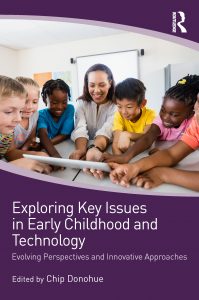
Let me set the scene. You’ve been invited to a roundtable conversation with 17 international thought leaders working at the intersection of child development, early learning and children’s media. As you look around the table, you see influential early childhood educators, researchers, academics, pediatricians, children’s media producers, advocates and policy experts. It is immediately clear that these leaders and innovators share a commitment to young children and child development first, technology second.
Milton Chen, senior fellow at the George Lucas Education Foundation, sets the table by offering this provocation in his foreword to the new book, Exploring Key Issues in Early Childhood and Technology: Evolving Perspectives and Innovative Approaches .
“Imagine yourself sitting at this distinguished table and how you might contribute to the conversation, as a researcher, teacher, media professional, activist, student, parent or caregiver… Interesting projects might merge for how families and communities can create the better digital environment we deserve. What could be more important to our democracy that the environment of ideas our children are raised in?”
This imagined dinner party conversation is a metaphor that captures the spirit of my third edited book with contributions from thought leaders in the United States, Australia, Great Britain, Israel, Scotland and Norway. Each author contributed a 2,000-word essay to this collection of powerful ideas about lessons learned, promising practices, innovative approaches and reflections on research and practice. Taken together, the essays offer a look at the groundbreaking work these innovators have done, and continue to do, to help define beneficial screen time and what positive experiences with interactive media should look like and include.
“When one enters a new domain of knowledge, one initially encounters a crowd of new ideas. Good learners are able to pick out those which are powerful.”
Seymour Papert*
Here are a few of the new ideas from the book that are powerful:
- In his essay, “Five Things that Haven’t Changed (Much),” David Kleeman, senior vice president for Global Trends for Dubit, suggests that “The concept of “screen time” has become meaningless in a world where screens bring entertainment, learning, discovery, communication, play, creation and more.”
- Lydia Plowman, from the University of Edinburgh in Scotland, writes “Designing for young children in a world of ambient computing provides a wonderful opportunity to explore the ways in which technology can provide fun, pleasure and play,” in her essay “When the Technology Disappears.”
- Kevin A. Clark, director of the Center for Digital Media Innovation and Diversity at George Mason University, contributed “Seeing is Believing: Racial Diversity in Children’s Media,” in which he offers this provocation: “Imagine what would happen if all children read books, saw television programs, watched movies, and played games that presented positive portrayals of people who look like them.”
- Michael H. Levine, former executive director of the Joan Ganz Cooney Center at Sesame Workshop, wrote an essay on “Digesting the iScreen Decade: What Should Media Makers, Policymakers and Philanthropy Do Next?” He writes: “Kids’ enthusiasm for digital activities presents a great “hook” for teachers and busy parents to manage their responsibilities, but if educators and parents themselves do not become technically proficient, the full range of digital possibilities—and the access to new technological tools, will effectively be reserved for the more privileged.”
- Lisa Guernsey, director of the Learning Technologies Project and senior advisor to the Early and Elementary Education Policy program at New America wrote an essay titled, “A Mission for Media Mentors: Creating Critical Thinkers.” “With ideas and guidance from media mentors, educators and parents can learn to take advantage of children’s natural curiosity to build their critical thinking skills about all the message they see and hear.”
 I invite you to read these essays, encounter new ideas, and “pick out those which are powerful” for your work with young children and technology.
I invite you to read these essays, encounter new ideas, and “pick out those which are powerful” for your work with young children and technology.
I started this blog post with words from Milton Chen’s foreword, and it seems fitting to leave you with his powerful and timely words.
“Perhaps it’s time to acknowledge that the digital environment is now as immersive, tangible, and vital to life as the physical environment. Creating a sustainable future is becoming as urgent for our children’s digital lives as the crises threatening our ecosystems, where extreme weather, air and water pollution, and climate change are on the rise. As Internet hacking, fake news, and divisive social media have shown, the climate is changing for our digital world, as well.”
Thanks to the thought leaders who contributed their powerful ideas and innovative approaches to this book: Marina Bers, Lewis Bernstein, Warren Buckleitner, Milton Chen, Kevin Clark, Susan Edwards, Shuli Gilutz, Lisa Guernsey, David Kleeman, Natalia Kucirkova, Michael Levine, Sonia Livingstone, Elena Lopez, Jackie Marsh, Lydia Plowman, Jenny Radesky, and Ellen Wartella
*Papert, S. (1980). Mindstorms: Children, computers, and powerful ideas, p. 137. New York, NY: Basic Books.
 Chip Donohue, PhD, is no longer at TEC Center at Erikson Institute but remains as Founding Director. He is a Senior Fellow and Member of the Advisory Board of the Fred Rogers Center for Early Learning and Children’s Media at Saint Vincent College, where he co-chaired the working group that revised the 2012 NAEYC & Fred Rogers Center Joint Position Statement on Technology and Interactive Media as Tools in Early Childhood Programs Serving Children from Birth through Age 8. Chip is the editor of Exploring Key Issues in Early Childhood and Technology: Evolving Perspectives and Innovative Approaches (2019),Family Engagement in the Digital Age: Early Childhood Educators as Media Mentors (2017), and Technology and Digital Media in the Early Years: Tools for Teaching and Learning (2015) co-published by Routledge/NAEYC. In 2012 he received the Bammy Award and Educators Voice Award as Innovator of the Year from the Academy of Education Arts & Sciences. In 2015, he was honored as a children’s media Emerging Pioneer at the KAPi (Kids At Play International) Awards. Follow Chip’s digital footprints as he travels the globe at @chipdono.
Chip Donohue, PhD, is no longer at TEC Center at Erikson Institute but remains as Founding Director. He is a Senior Fellow and Member of the Advisory Board of the Fred Rogers Center for Early Learning and Children’s Media at Saint Vincent College, where he co-chaired the working group that revised the 2012 NAEYC & Fred Rogers Center Joint Position Statement on Technology and Interactive Media as Tools in Early Childhood Programs Serving Children from Birth through Age 8. Chip is the editor of Exploring Key Issues in Early Childhood and Technology: Evolving Perspectives and Innovative Approaches (2019),Family Engagement in the Digital Age: Early Childhood Educators as Media Mentors (2017), and Technology and Digital Media in the Early Years: Tools for Teaching and Learning (2015) co-published by Routledge/NAEYC. In 2012 he received the Bammy Award and Educators Voice Award as Innovator of the Year from the Academy of Education Arts & Sciences. In 2015, he was honored as a children’s media Emerging Pioneer at the KAPi (Kids At Play International) Awards. Follow Chip’s digital footprints as he travels the globe at @chipdono.

